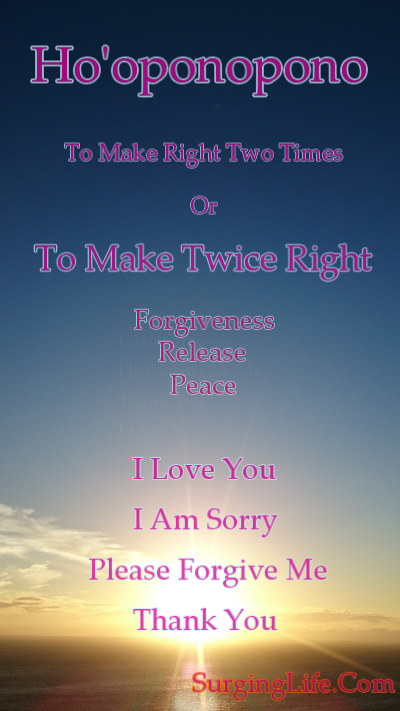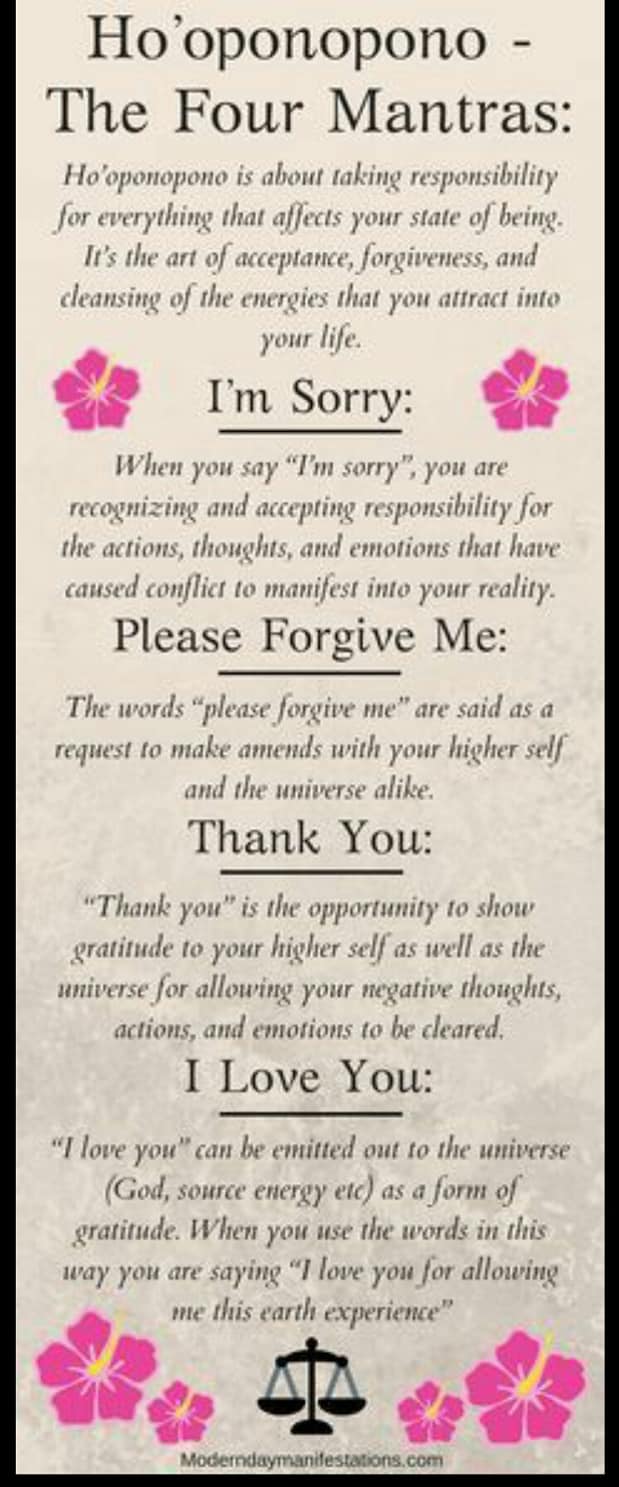I’m sure you’re curious about how often you should practice Ho’oponopono. Well, you’ve come to the right place! Ho’oponopono is a powerful technique that can help you heal and transform your life, but it’s essential to understand how frequently you should practice it to experience its full benefits.
In our upcoming article, we’ll dive deep into the topic and provide you with all the information you need to know about the frequency of Ho’oponopono practice. We’ll explain why consistency is important, how often you should repeat the practice, and share some helpful tips to incorporate it into your daily routine. So, stay tuned and get ready to discover how you can make Ho’oponopono a regular part of your self-healing and self-growth journey.
Understanding Ho’oponopono
Ho’oponopono is an ancient Hawaiian healing practice that focuses on resolving conflicts, healing emotional wounds, and restoring balance in relationships. The word “Ho’oponopono” can be translated as “to make right” or “to rectify an error.” It is a powerful practice that can bring about deep positive change in one’s life.
What is Ho’oponopono?
Ho’oponopono is a practice of reconciliation and forgiveness. It recognizes that every negative experience or conflict is a reflection of a disharmony within oneself. By taking responsibility for one’s own thoughts, actions, and emotions, Ho’oponopono aims to heal and restore harmony within oneself and in relationships with others.
The practice revolves around four simple phrases: “I’m sorry,” “Please forgive me,” “Thank you,” and “I love you.” These phrases are repeated either silently or out loud, with the intention of clearing negative energy and releasing any feelings of resentment, anger, or guilt.
History and origins of Ho’oponopono
Ho’oponopono has a rich history rooted in Hawaiian culture and traditions. It was traditionally practiced by families or communities as a way to resolve conflicts and restore harmony. In the past, it was primarily used to address issues within a community, but it has now evolved to encompass personal healing and growth.
The origins of Ho’oponopono can be traced back to the traditional spiritual practices of the native Hawaiians. It was believed that illness and disharmony were caused by “errors” or “misdeeds” and could be resolved through the practice of Ho’oponopono.
Core principles of Ho’oponopono
At the core of Ho’oponopono are four key principles:
-
Responsibility: Ho’oponopono emphasizes taking full responsibility for one’s own experiences. It recognizes that everything we encounter in our lives is a reflection of our own thoughts, beliefs, and emotions.
-
Forgiveness: Forgiveness is a fundamental aspect of Ho’oponopono. By seeking forgiveness for our own thoughts and actions, we can release the negative energy that prevents us from experiencing peace and harmony.
-
Gratitude: Gratitude is an integral part of the Ho’oponopono practice. Expressing gratitude for the opportunities to heal and grow allows us to shift our focus from negativity to positivity.
-
Love: Love is the ultimate healing force in Ho’oponopono. By cultivating a deep sense of love and compassion for ourselves and others, we can foster forgiveness, healing, and transformation.
Benefits of Practicing Ho’oponopono
Practicing Ho’oponopono can have numerous benefits for individuals seeking emotional healing, improved relationships, and personal growth.
Emotional healing and stress reduction
Ho’oponopono is a powerful tool for emotional healing and stress reduction. By taking responsibility for our emotions and releasing negative energy through the practice of Ho’oponopono, we can experience a sense of inner peace and emotional well-being.
The repetitive nature of the phrases used in Ho’oponopono can also serve as a form of meditation, helping to calm the mind and reduce stress. It allows us to let go of the past, release attachment to negative experiences, and focus on the present moment.
Improved relationships and communication
Ho’oponopono is deeply rooted in the concept of reconciliation and restoring harmony in relationships. By practicing Ho’oponopono, we can heal the wounds and conflicts that exist within our relationships, fostering greater understanding, empathy, and forgiveness.
The practice of Ho’oponopono can also enhance communication skills. By taking responsibility for our thoughts and actions, we can become more mindful of our words and how they may impact others. This increased self-awareness can lead to more authentic and open communication, deepening our connections with others.
Increased self-awareness and personal growth
Ho’oponopono is a transformative practice that promotes self-awareness and personal growth. By taking responsibility for our own experiences and emotions, we can gain a deeper understanding of ourselves and our patterns of behavior.
Through the practice of Ho’oponopono, we can uncover and heal unresolved emotional wounds, release limiting beliefs, and cultivate a greater sense of self-acceptance and love. This process of self-discovery and growth can lead to a more fulfilling and authentic life.

Factors to Consider
When deciding how often to practice Ho’oponopono, there are a few factors to consider.
Individual preferences and goals
Every individual is unique, and what works for one person may not work for another. It is important to consider your own preferences and goals when determining the frequency of your Ho’oponopono practice. Some individuals may prefer to practice daily, while others may find it more beneficial to engage in the practice on a weekly or monthly basis.
Availability of time and resources
Another important factor to consider is your availability of time and resources. Ho’oponopono can be practiced in a short amount of time, but it can also be expanded into longer sessions or even intensive retreats. Consider how much time and resources you are able to commit to your practice and adjust accordingly.
Level of commitment and consistency
Consistency is key when it comes to the practice of Ho’oponopono. It is important to establish a practice schedule that matches your level of commitment and consistency. The more consistently you practice, the more likely you are to experience the benefits of Ho’oponopono.
Frequency of Practice
There is no one-size-fits-all answer to how often one should practice Ho’oponopono. The frequency of practice can vary depending on individual needs and preferences.
Daily practice
A daily practice of Ho’oponopono can be highly beneficial for maintaining emotional well-being and personal growth. By incorporating Ho’oponopono into your daily routine, you can cultivate a sense of peace and harmony in your life on a regular basis.
A daily practice does not have to be time-consuming. It can be as simple as repeating the four phrases of Ho’oponopono for a few minutes each day. This consistency allows you to continuously release negative energy and maintain a positive mindset.
Weekly practice
If daily practice feels overwhelming or difficult to sustain, a weekly practice can be a good alternative. Setting aside a specific day each week to engage in Ho’oponopono can provide a dedicated space for reflection and healing.
During your weekly practice, you can spend more time diving deeper into your emotions, beliefs, and patterns of behavior. This extended practice session allows for a more thorough healing process and can help you make significant progress over time.
Monthly practice
For those who have limited time or prefer a less frequent practice schedule, a monthly practice can still yield positive results. Designate a specific day each month for an extended Ho’oponopono practice session.
During your monthly practice, you can take the time to reflect on your experiences and emotions from the previous month, identify areas of growth, and set intentions for the upcoming month. This monthly practice allows for a more comprehensive review of your progress and can serve as a powerful tool for personal transformation.

Setting a Practice Schedule
Establishing a practice schedule is crucial for maintaining consistency and making Ho’oponopono a regular part of your life.
Identifying suitable practice time
When setting a practice schedule, it is important to identify a time that works best for you. This could be in the morning before starting your day, during a lunch break, or in the evening before bedtime. Choose a time when you are least likely to be interrupted and when you can fully focus on your practice.
Creating a dedicated practice space
Creating a dedicated practice space can help set the tone for your Ho’oponopono practice. Choose a quiet and comfortable area where you can sit or lie down without distractions. Decorate the space with items that inspire calmness and relaxation, such as candles, incense, or meaningful objects.
Incorporating Ho’oponopono into daily routine
To make Ho’oponopono a habit, it can be helpful to incorporate it into your daily routine. For example, you can practice Ho’oponopono while brushing your teeth, during your morning commute, or before going to bed. By integrating it into activities you already do daily, you can ensure that you consistently engage in the practice.
Duration of Practice Sessions
The duration of your Ho’oponopono practice sessions can vary depending on your preferences and available time.
Short daily sessions
If you have limited time, short daily practice sessions can still be effective. Even just a few minutes of focused practice can help release negative energy and promote emotional healing. Set a timer for five to ten minutes and repeat the four phrases of Ho’oponopono. Focus on each phrase and allow yourself to truly feel the intention behind it.
Extended weekly sessions
For those seeking a deeper healing experience, extended weekly sessions can be beneficial. Set aside 30 minutes to an hour each week to engage in a more thorough Ho’oponopono practice. During this time, you can explore and reflect on specific issues or emotions that have arisen during the week. Use this dedicated time to release any negative energy and make space for healing and growth.
Intensive retreats or workshops
For a more immersive and transformative experience, consider participating in an intensive Ho’oponopono retreat or workshop. These retreats typically span multiple days or weeks and provide a focused space for deep healing and personal growth. They often include guided practices, group discussions, and individual reflection time. While more time-consuming and resource-intensive, these retreats can offer profound insights and lasting transformation.

Guided vs. Independent Practice
When practicing Ho’oponopono, you can choose between guided or independent practice, depending on your preference and experience level.
Using guided meditations or recordings
Guided meditations and recordings can be helpful for beginners or those who prefer a more structured practice. These resources provide step-by-step instructions and help create a supportive environment for your Ho’oponopono practice. They can be easily found online or through various meditation apps.
Developing a personalized practice
As you become more familiar with Ho’oponopono, you may feel ready to develop your own personalized practice. This can involve incorporating additional practices or rituals that resonate with you. For example, you can combine your Ho’oponopono practice with journaling, visualization, or affirmations. Tailoring the practice to your unique needs and preferences can enhance its effectiveness and make it more meaningful for you.
Seeking guidance from experienced practitioners
If you feel unsure about your practice or would like guidance from experienced practitioners, consider seeking a mentor or joining a Ho’oponopono group. Experienced practitioners can offer insights, answer questions, and provide support as you navigate your Ho’oponopono journey. Connecting with like-minded individuals can also help create a sense of community and accountability.
Monitoring Progress and Adaptation
Regularly monitoring your progress and adapting your practice as needed is essential for maximizing the benefits of Ho’oponopono.
Self-reflection and journaling
One way to monitor your progress is through self-reflection and journaling. Take the time to write down your experiences, thoughts, and emotions before and after each practice session. This allows you to track your journey, identify patterns, and observe any shifts or changes in your well-being. Journaling can also serve as a valuable tool for exploring deeper emotions and gaining insights into your healing process.
Seeking feedback and support
Seeking feedback and support from others can also provide valuable perspectives and insights. Share your experiences with trusted friends, family members, or fellow practitioners. Engage in conversations about Ho’oponopono and actively listen to others’ experiences. This exchange of ideas and support can help validate your own experiences and provide guidance when needed.
Adjusting practice as needed
As you progress on your Ho’oponopono journey, you may find that your practice needs adjustments. You may discover new techniques, rituals, or variations of Ho’oponopono that resonate more deeply with you. Be open to adapting and evolving your practice to suit your changing needs and preferences. Remember that Ho’oponopono is a personal journey, and your practice should reflect your unique experiences and intentions.

Maintaining Consistency and Motivation
Maintaining consistency and motivation in your Ho’oponopono practice can sometimes be challenging. Here are some strategies to help keep you on track.
Accountability and support networks
Find an accountability partner or join a Ho’oponopono support group to help you stay committed to your practice. By sharing your intentions and progress with others, you create a sense of responsibility and support. Regular check-ins and discussions can provide encouragement and motivation.
Revisiting intentions and goals
Regularly revisit your intentions and goals for practicing Ho’oponopono. Reflect on why you started this journey and the positive changes you have experienced along the way. Remind yourself of the transformations you seek and the impact they can have on your life. By reconnecting with your intentions, you can reignite your motivation and stay focused on your practice.
Finding inspiration in success stories
Seek inspiration from the success stories of others who have experienced the power of Ho’oponopono. Read books, watch videos, or listen to podcasts that share personal accounts of how Ho’oponopono has positively impacted people’s lives. Hearing about the transformative journeys of others can reignite your own motivation and reaffirm the potential of Ho’oponopono.
Conclusion
In conclusion, the frequency of practicing Ho’oponopono is a personal choice that should align with your goals, preferences, and available resources. Whether you choose to practice daily, weekly, or monthly, the key is consistency and commitment. Embrace the transformative power of Ho’oponopono and allow it to guide you on a journey of self-discovery, healing, and personal growth. Remember, your practice, your commitment, and your dedication are the key ingredients in harnessing the full potential of Ho’oponopono.

